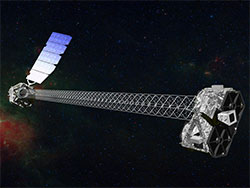Observatories Across the Electromagnetic Spectrum
Observatories Across the Electromagnetic Spectrum
Astronomers use a number of telescopes sensitive to different parts of the electromagnetic spectrum to study objects in space. Even though all light is fundamentally the same thing, the way that astronomers observe light depends on the portion of the spectrum they wish to study.
For example, different detectors are sensitive to different wavelengths of light. In addition, not all light can get through the Earth's atmosphere, so for some wavelengths we have to use telescopes aboard satellites. Even the way we collect the light can change depending on the wavelength. Here we briefly introduce observatories used for each band of the EM spectrum.
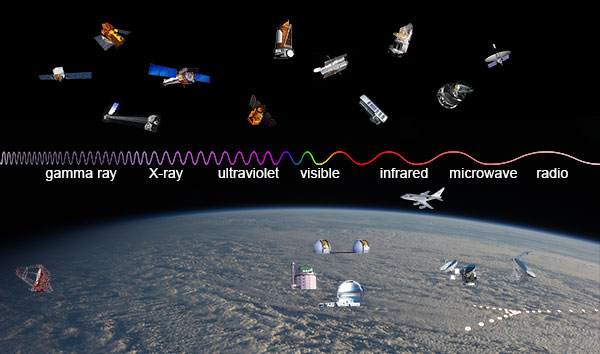
A sample of telescopes (operating as of February 2013) operating at wavelengths across the electromagnetic spectrum. Observatories are placed above or below the portion of the EM spectrum that their primary instrument(s) observe.
The represented observatories are: HESS, Fermi and Swift for gamma-ray, NuSTAR and Chandra for X-ray, GALEX for ultraviolet, Kepler, Hubble, Keck (I and II), SALT, and Gemini (South) for visible, Spitzer, Herschel, and Sofia for infrared, Planck and CARMA for microwave, Spektr-R, Greenbank, and VLA for radio. Click here to see this image with the observatories labeled.
(Credit: Observatory images from NASA, ESA (Herschel and Planck), Lavochkin Association (Specktr-R), HESS Collaboration (HESS), Salt Foundation (SALT), Rick Peterson/WMKO (Keck), Germini Observatory/AURA (Gemini), CARMA team (CARMA), and NRAO/AUI (Greenbank and VLA); background image from NASA)
![]() Try your hand at building an observatory with the Build It Yourself: Satellite! Game
Try your hand at building an observatory with the Build It Yourself: Satellite! Game
Radio observatories
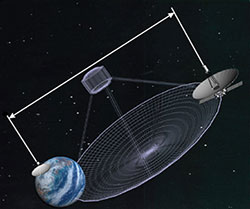
This artist's conception shows Earth and the Spektr-R spacecraft with an imagined radio antenna that is created by combining Spektr-R's data with that of Earth-bound radio telescopes. (Credit: Lavochkin Association)
Radio waves can make it through the Earth's atmosphere without significant obstacles. In fact, radio telescopes can observe even on cloudy days. In principle, then, we don't need to put radio telescopes in space. However, space-based radio observatories complement Earth-bound radio telescopes in some important ways.
A special technique used in radio astronomy is called "interferometry." Radio astronomers can combine data from two telescopes that are very far apart and create images that have the same resolution as if they had a single telescope as big as the distance between the two telescopes. This means radio telescope arrays can see incredibly small details. One example is the Very Large Baseline Array (VLBA), which consists of 10 radio observatories that reach from Hawaii to Puerto Rico, nearly a third of the way around the world.
By putting a radio telescope in orbit around Earth, radio astronomers can make images as if they had a radio telescope the size of the entire planet. The first mission dedicated to space interferometry was the Japanese HALCA mission which ran from 1997 to 2005. The second dedicated mission is the Russian Spektr-R satellite, which launched in 2011.
Microwave observatories
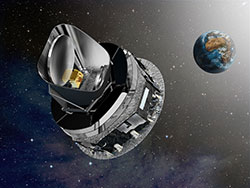
Artist's conception of the European Space Agency's (ESA's) Planck observatory cruising to its orbit. (Credit: ESA/D. Ducros)
The Earth's atmosphere blocks much of the light in the microwave band, so astronomers use satellite-based telescopes to observe cosmic microwaves. The entire sky is a source of microwaves in every direction, most often referred to as the cosmic microwave background (or CMB for short). These microwaves are the remnant of the Big Bang, a term used to describe the early universe.
A very long time ago, all the matter in existence was scrunched together in a very small, hot ball. The ball expanded outward and became our universe as it cooled. Since the Big Bang, which is estimated to have taken place 13.8 billion years ago, it has cooled all the way to just three degrees above absolute zero. It is this "three degrees" that we measure as the microwave background.
The first precise measurements of the temperature of the microwave background across the entire sky was done by the Cosmic Background Explorer (COBE) satellite from 1989 to 1993. Since then, the Wilkinson Microwave Anisotropy Probe (WMAP) refined the COBE measurements, operating from 2001 to 2010. More recently, the Planck mission launched in 2009 and further improved astronomer's understanding of the CMB.
Infrared observatories

Artist's conception of SOFIA flying at sunset (Credit: NASA)
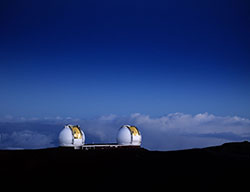
Photograph of the Keck I and II domes at dawn; the Keck telescopes operate in visible and infrared wavelengths. (Credit: Rick Peterson/WMKO)
Infrared astronomy has to overcome a number of challenges. While some infrared radiation can make it through Earth's atmosphere, the longer wavelengths are blocked. But that's not the biggest challenge – everything that has heat emits infrared light. That means that the atmosphere, the telescope, and even the infrared detectors themselves all emit infrared light.
Ground-based infrared telescopes reside at high altitudes in dry climates in an effort to get above much of the water vapor in the atmosphere that absorbs infrared. However, ground-based infrared observatories must still account for the atmosphere in their measurements. To do this, the infrared emission from the atmosphere is measured at the same time as the measurement of the cosmic object being observed. Then, the emission from the atmosphere can be subtracted to get an accurate measurement of the cosmic object. The telescopes, for both ground-based and space/airborne observatories, are also designed to limit the spurious infrared radiation from reaching the detector, and the detectors are cooled to limit their infrared emissions.
In 2003, NASA launched the Spitzer Space Telescope into an earth-trailing, heliocentric orbit, where it did not have to contend with the comparatively warm environment in near-Earth space. Another major infrared facility is the Stratospheric Observatory for Infrared Astronomy (SOFIA). SOFIA carries a large telescope inside a 747 aircraft flying at an altitude sufficient to get it well above most of the Earth's infrared absorbing atmosphere.
Scheduled for launch in 2018, the James Webb Space Telescope is a large, space-based observatory, that is optimized for infrared wavelengths. Webb will be able to look further back in time to find the first galaxies that formed in the early Universe and to peer inside dust clouds where stars and planetary systems are forming today. Webb will also be in a heliocentric orbit at the second Lagrange point. To keep the mirror and instruments cold (and allow the telescope to detect the faintest of heat signals from distant objects), it has a giant sunshield, which will block the light and heat from the Earth, Sun, and Moon.
Visible spectrum observatories

The Hubble Space Telescope just after it was captures by the Space Shuttle Atlantis to be serviced in 2009. (Credit: NASA)
Visible light can pass right through our atmosphere, which is why astronomy is as old as humanity. Ancient humans could look up at the night sky and see the stars above them. Today, there is an army of ground-based telescope facilities for visible astronomy (also called "optical astronomy"). However, there are limits to ground-based optical astronomy. As light passes through the atmosphere, it is distorted by the turbulence within the air. Astronomers can improve their chances of a good image by putting observatories on mountain-tops (above some of the atmosphere), but there will still be limits to how crisp their images will be, especially for faint sources.
Visible-light observatories in space avoid the turbulence of the Earth's atmosphere. In addition, they can observe a somewhat wider portion of the electromagnetic spectrum, in particular ultraviolet light that is absorbed by the Earth's atmosphere. The Hubble Space Telescope is perhaps the most famous optical telescope in orbit. Also in orbit is the Kepler observatory. Kepler is using visible light to survey a portion of the Milky Way galaxy to discover planetary systems. The Swift satellite also carries an UltraViolet and Optical Telescope (the UVOT) to perform observations of gamma-ray bursts.
Ultraviolet observatories
The Earth's atmosphere absorbs ultraviolet light, so ultraviolet astronomy must be done using telescopes in space. Other than carefully-select materials for filters, a ultraviolet telescope is much like a regular visible light telescope. The primary difference being that the ultraviolet telescope must be above Earth's atmosphere to observe cosmic sources.
The GALEX observatory was the most recent dedicated ultraviolet observatory. It was launched in 2003 and shut down operations in 2013. Its goal was to observe the history of star formation in our Universe in ultraviolet wavelengths, and it observed over a half-billion galaxies going back to when our Universe was just about 3 billion years old.
The Hubble Space Telescope and the UltraViolet and Optical Telescope on Swift can both perform a great deal of observing at ultraviolet wavelengths, but they only cover a portion of the spectrum that GALEX observes.
X-ray observatories
X-ray wavelengths are another portion of the electromagnetic spectrum that are blocked by Earth's atmosphere. X-rays also pose a particular challenge because they are so small and energetic that they don't bounce off mirrors like lower-energy forms of light. Instead, they pass right through. Unless they just barely graze the surface of the mirror. (Read more about how X-rays are focused on the X-ray Telescope Introduction page.)
Focusing X-ray telescope require long focal lengths. In other words, the mirrors where light enters the telescope must be separated from the X-ray detectors by several meters. However. launching such a large observatory is costly and limits the launch vehicles to only the most powerful rockets (the Space Shuttle in the case of the Chandra X-ray Observatory).
In 2012, the Nuclear Spectroscopic Telescope Array (or NuSTAR for short), solved this problem by designing an observatory with a deployable mast. In other words, NuSTAR was designed with its mirror module and detector module on a mast, or boom, that could be extended once it was in orbit. By doing that, NuSTAR could be launched on a low-cost rocket.
Gamma-ray observatories
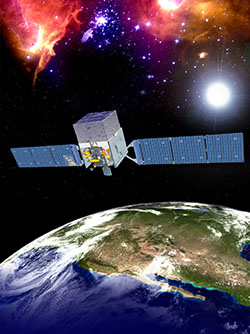
Artist's concept of the Fermi satellite. (Credit: NASA)

One of the HESS telescopes. (Credit: HESS Collaboration)
Not only are gamma-rays blocked by Earth's atmosphere, but they are even harder than X-rays to focus. In fact, so far, there have been no focusing gamma-ray telescopes. Instead, astronomers rely on alternate ways to determine where in the sky gamma-rays are produced. This can be properties of the detector or using special "masks" that cast gamma-ray shadows on the detector.
![]() Tell me more about Gamma-ray Telescopes and Detectors
Tell me more about Gamma-ray Telescopes and Detectors
The Swift satellite was launched in 2004 to help solve the mystery of gamma-ray bursts. Swift has a gamma-ray detector that can observe half the sky at a time, and if it detects a gamma-ray burst, the satellite can quickly point its X-ray and optical telescopes in the direction of the burst. The Fermi Space Telescope was launched in 2008 and is designed to study energetic phenomena from a variety of cosmic sources, including pulsars, black holes, active galaxies, diffuse gamma-ray emission and gamma-ray bursts.
It might be surprising to know that astronomers can use ground-based astronomy to detect the highest energy gamma-rays. For these gamma-rays, the telescopes don't detect the gamma-rays directly. Instead, they use the atmosphere itself as a detector. The HESS array has been in operation for over 10 years. The array began with four telescopes arranged in a square, and recently added the HESS II telescope to its ranks.
![]() Tell me more about detecting gamma-rays using the atmosphere
Tell me more about detecting gamma-rays using the atmosphere
Updated: February 2013


